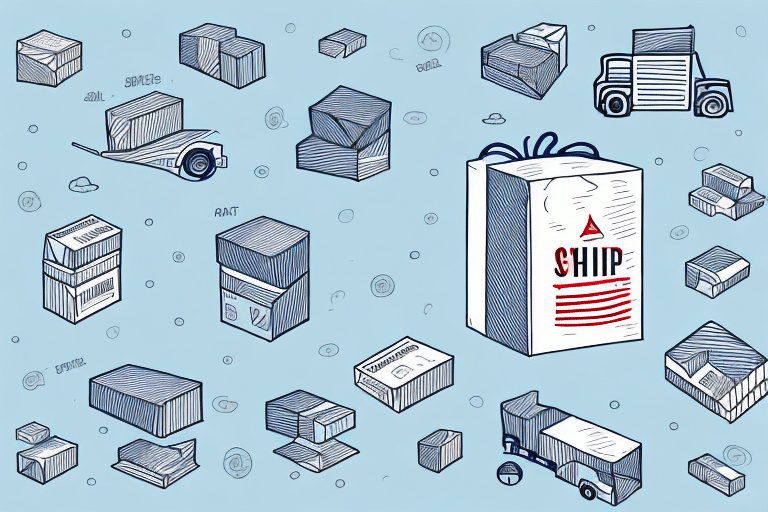Find the Cheapest 2-3 Day 1 lb Shipping Rates with Carriers
As a business owner, managing shipping costs is a crucial part of ensuring profitability and customer satisfaction. One way to reduce shipping costs is to find the cheapest 2-3 day 1 lb shipping rates with carriers. In this article, we will discuss why finding the cheapest shipping rates is important, how to compare rates from various carriers, tips for negotiating better rates, and much more.
Why Finding the Cheapest 2-3 Day Shipping Rates is Important for Businesses
Shipping costs can take a significant toll on a business's bottom line. By finding the cheapest shipping rates, businesses can reduce their expenses and allocate resources to other areas of the business. Offering competitive shipping rates is also important for customer satisfaction and retention. Customers are becoming increasingly sensitive to shipping costs, and providing affordable rates can give a business a competitive edge in the market.
In addition to cost savings and customer satisfaction, finding the cheapest 2-3 day shipping rates can also improve a business's environmental impact. By choosing shipping carriers that prioritize sustainability and offer eco-friendly options, businesses can reduce their carbon footprint and contribute to a more sustainable future. This can also be a selling point for environmentally conscious customers who prioritize eco-friendly practices when choosing where to shop.
Understanding Shipping Carriers and Their Pricing Structures
Before comparing shipping rates, it's important to understand how carriers price their services. Some carriers charge based on the weight of the package, while others charge based on the dimensions. Additionally, carriers may offer discounts based on the volume of shipments or the length of the contract. Understanding these pricing structures can help businesses make informed decisions when selecting a carrier.
It's also important to consider the speed of delivery when selecting a carrier. Some carriers offer expedited shipping options for an additional fee, while others may have longer delivery times but lower prices. Businesses should evaluate their shipping needs and determine which carrier can provide the most cost-effective and efficient solution.
Comparing Shipping Rates from Various Carriers for 1 lb Packages
Once you understand the pricing structures, it's time to compare rates from various carriers. Some of the most popular carriers include UPS, FedEx, and USPS. Each carrier offers different services and pricing options, so it's important to compare apples-to-apples when making a decision. Consider factors such as delivery time frames, pickup options, and insurance options when comparing rates.
It's also important to keep in mind that shipping rates can vary depending on the destination and the type of package being shipped. For example, shipping a 1 lb package to a residential address may cost more than shipping the same package to a commercial address. Additionally, certain carriers may offer discounted rates for specific types of packages or for customers who ship frequently. Be sure to do your research and compare rates for your specific shipping needs to ensure you are getting the best deal.
Tips for Negotiating Better Shipping Rates with Carriers
Negotiating shipping rates with carriers can be a daunting task, but it can result in significant cost savings. Here are some effective strategies:
- Leverage Shipping Volume: Approach multiple carriers with your shipping volume and ask for a discount.
- Highlight Loyalty: Use your history with a carrier as leverage, highlighting your loyalty and asking for discounted rates in return.
- Timing: Negotiate during slower shipping seasons or when carriers have excess capacity.
- Clear Requirements: Have a clear understanding of your shipping needs, including delivery timelines and packaging specifications.
- Alternative Shipping Methods: Explore using freight forwarders or consolidators who can negotiate better rates on behalf of multiple shippers.
How to Use Online Tools to Find the Cheapest Shipping Rates for Your Business
There are a variety of online tools that businesses can use to compare shipping rates. These tools allow you to enter the package information, compare rates from multiple carriers, and select the cheapest option. Some popular tools include:
It's important to note that while finding the cheapest shipping rates is important, it's also crucial to consider other factors such as delivery time, package tracking, and customer service. Some online tools offer additional features such as real-time tracking and automatic notifications to keep your customers informed about their package's delivery status. It's important to weigh all of these factors when selecting a shipping carrier and using online tools to find the best rates.
Common Mistakes to Avoid When Selecting a Carrier for Your Shipments
When selecting a carrier, it's important to avoid common mistakes that can result in higher costs and lower customer satisfaction:
- Choosing Based Solely on Price: Selecting the cheapest option without considering delivery time frames and package handling can lead to delays and unhappy customers.
- Inadequate Rate Comparison: Failing to compare rates from multiple carriers can result in missed opportunities for savings.
- Ignoring Carrier Reputation: Not considering the carrier's reputation for on-time delivery and customer service can hurt your business.
- Poor Packaging and Labeling: Failing to properly package and label shipments can lead to additional costs and delays.
Make sure to research carriers, read reviews from other businesses, and follow carrier guidelines for packaging and labeling to ensure reliable and cost-effective shipping.
How to Save Money on Shipping Costs Without Compromising Quality or Speed of Delivery
Reducing shipping costs doesn't have to mean sacrificing quality or speed of delivery. Here are some strategies to consider:
- Optimize Packaging: Use flat rate boxes or optimize packaging sizes to reduce dimensional weight charges.
- Leverage Discounts: Take advantage of discounts offered by carriers and third-party logistics providers.
- Automate Shipping Processes: Automating shipping can reduce labor costs and increase efficiency.
- Negotiate Rates: If you have a high volume of shipments, negotiate lower rates based on your shipping volume.
- Regularly Review Invoices: Ensure you are being charged correctly and identify areas where you can further reduce costs.
- Offer Free Shipping Strategically: Offer free shipping on orders over a certain amount or during specific promotions to drive sales and increase customer loyalty.
Benefits of Working with a Third-Party Logistics Provider for Your Shipping Needs
Working with a third-party logistics provider (3PL) can offer a range of benefits for businesses, including:
- Cost Savings: 3PLs can negotiate better rates with carriers due to their volume purchasing power.
- Increased Efficiency: They handle all aspects of shipping, from carrier selection to package tracking.
- Advanced Technology: Access to sophisticated logistics technology for better tracking and management.
- Flexibility and Scalability: 3PLs can adjust services as your business grows and your shipping needs change.
- Enhanced Customer Service: Improved delivery times and reliability lead to higher customer satisfaction.
For more information on the benefits of 3PLs, refer to industry analyses from sources like Inbound Logistics and Supply Chain Digital.
Best Practices for Tracking and Managing Shipments to Ensure Timely Delivery
Tracking and managing shipments is essential for ensuring timely delivery and customer satisfaction. Here are some best practices:
- Utilize Carrier Tracking Tools: Use the tracking systems provided by carriers to monitor shipments in real-time.
- Provide Customers with Tracking Information: Keep customers informed by sharing tracking numbers and updates.
- Proactively Address Potential Issues: Monitor for potential delays such as weather disruptions or logistical challenges and communicate proactively with customers.
- Implement Automated Notifications: Use software that automatically notifies customers of their shipment status.
Real-Life Examples of Businesses that Have Saved Money on Shipping Costs by Switching Carriers
Switching carriers can result in significant cost savings for businesses. Here are some real-life examples:
- Small eCommerce Business: Saved over $30,000 per year by switching carriers and negotiating better rates.
- Retail Business: Saved over 40% on shipping costs by utilizing a 3PL.
- Large Retail Chain: Saved millions annually by implementing a multi-carrier shipping strategy, optimizing shipping routes, and ensuring backup options in case of carrier delays.
These examples highlight the importance of evaluating shipping strategies and being open to change to achieve significant savings.
Strategies for Reducing Packaging and Shipping Material Costs While Maintaining Quality Standards
Reducing packaging and shipping material costs can lead to significant savings without compromising quality. Here are some strategies:
- Utilize Eco-Friendly Materials: Use sustainable packaging materials that can reduce costs and appeal to environmentally conscious customers.
- Optimize Packaging Sizes: Ensure that packaging is appropriately sized to reduce dimensional weight charges and material usage.
- Use Flat Rate Boxes: Take advantage of flat rate shipping options to manage costs effectively.
- Negotiate with Suppliers: Negotiate better pricing with packaging suppliers or find alternative suppliers for cost savings.
- Regularly Review Shipping Data: Analyze shipping data to identify areas where costs can be reduced, such as consolidating shipments or using more efficient shipping methods.
Maintaining quality standards is crucial to prevent damaged packages, which can lead to decreased customer satisfaction and increased costs.
The Impact of Shipping Costs on Customer Satisfaction and Retention, and How to Address This Issue
Shipping costs have a significant impact on customer satisfaction and retention. Customers are more likely to return to businesses that offer affordable and efficient shipping options. Addressing this issue requires a multifaceted approach:
- Analyze Shipping Costs: Regularly review your shipping expenses to identify opportunities for savings.
- Negotiate Rates: Work with carriers to secure the best possible rates based on your shipping volume and needs.
- Optimize Packaging and Shipping Processes: Streamline your shipping operations to reduce costs without sacrificing quality or speed of delivery.
- Offer Flexible Shipping Options: Provide customers with a variety of shipping choices to meet their preferences and budgets.
- Communicate Transparently: Clearly communicate shipping costs and options to customers at checkout to manage expectations.
In conclusion, finding the cheapest 2-3 day 1 lb shipping rates with carriers is an essential part of managing shipping costs for businesses. By understanding carrier pricing structures, comparing rates from various carriers, negotiating rates, and utilizing online tools and third-party logistics providers, businesses can reduce costs and satisfy customers. It's important to maintain quality standards throughout these processes to ensure timely delivery and customer satisfaction.
Another important factor to consider when addressing shipping costs is the impact of shipping on the environment. As consumers become more environmentally conscious, they are increasingly looking for businesses that prioritize sustainability in their shipping practices. This can include using eco-friendly packaging materials, optimizing shipping routes to reduce emissions, and partnering with carriers that have a strong commitment to sustainability. By prioritizing sustainability in their shipping practices, businesses can not only reduce costs but also attract and retain environmentally conscious customers.






















